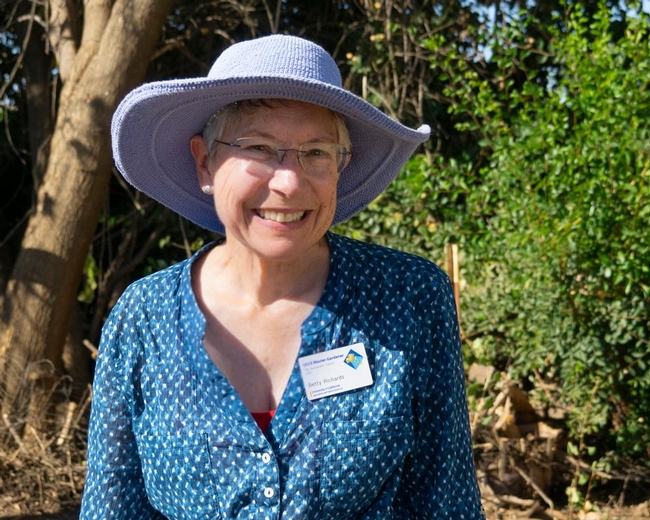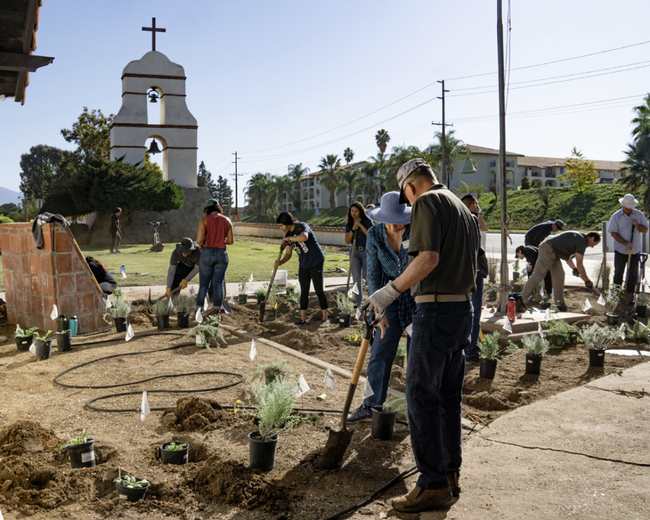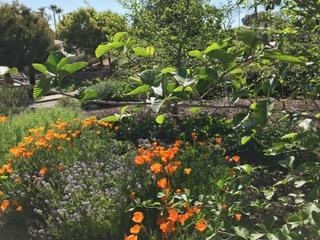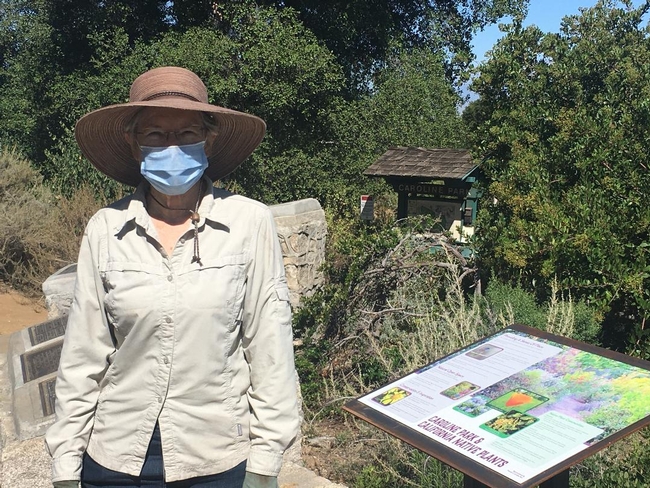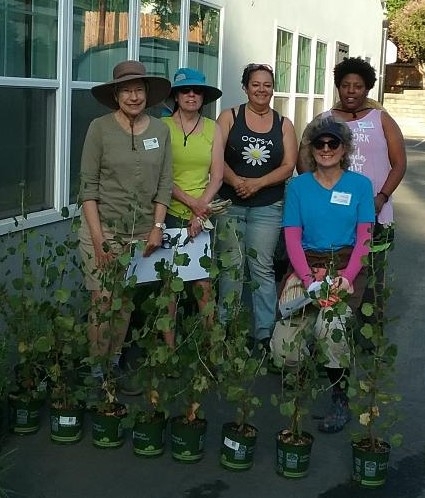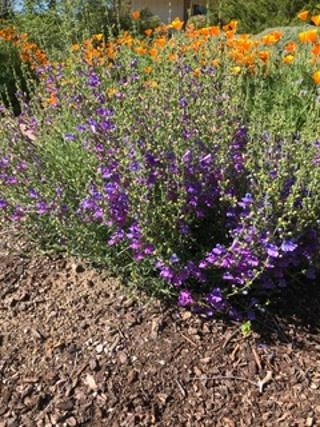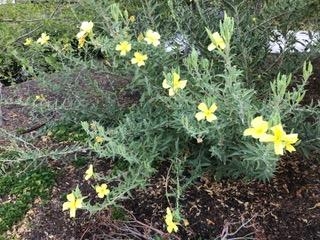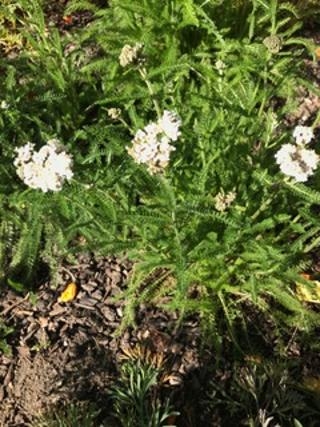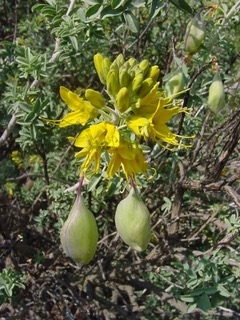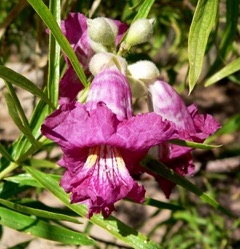I recently enjoyed taking a “virtual garden walk” with UCCE San Bernardino County Master Gardener Betty Richards (class of 2016) while chatting on a Zoom call with her.
I came away from our meeting with the distinct impression that the gardening world is a better place with Betty in it. She has always had a deep interest in our environment and what individuals can do to protect it and make it a better place to thrive.
With increased awareness of the importance of native plants to birds, bees, butterflies, and our environment, Betty has become more active in promoting California native plants in home gardens. With her science background (she is a retired physician), coupled with a passion for sustainable gardening and protecting the environment, she has a winning combination for success.
Betty not only believes in the UC Master Gardener mission of sustainable gardening but exhibits her beliefs through her actions and participation in numerous volunteer activities. Volunteering for various Master Gardener activities has allowed Betty to meet people and find out about other projects that interest her. She has successfully and tirelessly led many Master Gardener projects.
Betty and fellow Master Gardeners designed the native plants demonstration garden at the historic Asistencia on Barton Road in West Redlands. The Asistencia was acquired by the Redlands Conservancy to teach about the history of Redlands, the history of native Californians, and as a place to demonstrate the importance of incorporating native plants in neighborhood landscapes. In November 2019, Betty worked with a large group of volunteers from the UC Master Gardeners and the local community to plant the demonstration garden. She continues to be involved in the Asistencia project by educating the staff about caring for the native plants. She is currently working with fellow Master Gardeners Heather Ross and Heather Nichol on designing and implementing the main front garden area and a cactus/succulent garden at the Asistencia. We look forward to seeing the changes that Betty and the UC Master Gardeners team and other community volunteers make to the Asistencia gardens.
Betty is the main organizer of the UCCE San Bernardino County Master Gardeners' presence at the Redlands Farmers' Market. She coordinates volunteers, makes sure the Master Gardener information table is set up, and that printed gardening materials are available to give out to people who stop by. Betty says it is fun to talk to the folks who visit. Working at the Farmers' Market is an excellent opportunity to get to know fellow master gardeners working at the table and trade gardening tips. Betty is looking forward to COVID restrictions being lifted so the Master Gardeners can get back to providing research-based answers to gardening questions!
In early 2020, Betty started organizing a quarterly series of talks by Master Gardeners at the Redlands Community Center on Lugonia Avenue. This was begun, as an educational activity for gardeners from the city's community gardens and attracted many community members. Betty hopes to continue these well-attended talks when COVID restrictions are lifted and the community center reopens.
Last spring, UCCE San Bernardino County Master Gardeners Betty Richards, Linda Richards (no relation to Betty), and Brenda Spoelstra got together with the California Native Plant Society's local chapter and planned a tour of their local native gardens. Each of the three yards was in different lawn replacement stages with low water-use plants – Brenda Spoelstra's new drought-tolerant space, Betty Richards' maturing (3-5 years) garden, and Linda Richards' mature garden. When the COVID 19 pandemic made the tour impossible, they made virtual tours of the gardens and posted them online https://ifnaturecouldtalk.com/youre-invited-to-virtually-visit-three-california-gardens.
Gardens such as the three featured in the native plants video take time and care. The transition of Betty's lawn to a native plants garden has evolved over the past 3-5 years, and continues to evolve. In 2015, she decided she would begin the process of transitioning the water-thirsty lawn at her home to California natives and other low water use plants. She started the process by learning all she could about which native plants to grow in her garden. She took a class on how to grow native plants at the Rancho Santa Ana Botanical Garden (now California Botanical Garden) in Claremont, California. The 86 acres garden is a non-profit organization dedicated to California native plants. Events and classes are offered throughout the year.
Betty also researched native plants on the California Native Plant Society Calscape website https://calscape.org/. She recommends the website to anyone interested in making the transition to a native plants garden. It is an excellent source of information about which plants are native to any location in the state. It helps people figure out which plants to use, where to buy the plants and how to grow them.
When Betty started to work on the transition, she decided to leave a group of existing White Alder trees that thrived in the well-watered lawn space. She added an extension to a pre-existing drip irrigation line to continue to give the trees the irrigation they needed. After putting in a path of decomposed granite she planted a group of three desert willows and added other low-water-requiring native shrubs and perennials. Every year she adds a few more plants and throws out some wildflower seeds before the first winter rains.
She has recently added a birdbath to encourage birds to stop by and visit the garden. Over the years, she has seen an increase in native bees, butterflies, and birds. Her water bill has even decreased significantly! The evolution of Betty's garden continues with plans to add keystone species of plants to the landscape. Keystone plants for our local area such as live oaks, ceanothus, coyote brush, and black sage are especially important in supporting a diversity of life.
For the past year, Betty has been working as a volunteer at Caroline Park in Redlands. The City of Redlands 16+ acres park is planted with California native plants. On Tuesday mornings, a small, dedicated crew works to remove invasive non-native plants, prune, and maintain the plants and trails. If you have the opportunity, take a walk in Caroline Park to see which California native plants are blooming. The park is primarily a great example of the dwindling Coastal Sage, although it also showcases several habitats, including woodlands and various chaparral plants. Betty would love readers to view the beautifully produced video she made to spread the word about this local native plants gem https://www.youtube.com/watch?v=v7FQAb0AuOI. She hopes that the video will inspire people to plant some natives in their home landscape. I have viewed the video several times and am always touched by the “visual poem” created by Betty to the park.
In the summer of 2018, Betty and fellow UC Master Gardeners Anita Matlock and Trisha Fitzgerald participated in transforming a grassy area in the front yard of Micah House into a lovely drought-tolerant garden. Micah House in North Redlands is an after-school educational program for children and youth from 1st through 12th grades. It provides homework help, tutoring, literacy education and character-building themes and extracurricular activities, including gardening, art, music, and bike restoration.
Master Gardeners removed the existing lawns and replaced them with drought-tolerant plants watered by a new drip irrigation system. They partnered with Micah House staff, families of their after-school program, and the community. On planting the day, they worked with volunteers from Trinity Church and children and staff from the Micah House program to put the finishing touches on the water-wise garden. The project was made possible through a grant from the Inland Empire Resource Conservation District (IERCD). (Betty also serves as an advisory committee member for the IERCD/UCCE Master Gardener partnership which helps UCCE programs reach over 35,000 county residents each year.)
Betty has always been interested in outdoor activities such as gardening, birding, hiking, and camping. She has done some vegetable gardening in raised beds and some planting of “this and that about the yard.” So, when she heard about the UC Master Gardener program through a friend who was applying to Riverside County's class, she applied to the UC San Bernardino County course. The UCCE San Bernardino County Master Gardeners are thankful that Betty took that step and joined.
Betty says that what she likes best about the Master Gardener program is meeting new friends who love to garden and share their gardening knowledge. She encourages anyone interested in becoming a Master gardener to apply. “There are many opportunities to try different gardening areas. It doesn't matter whether you are a very experienced gardener, an enthusiastic beginner, an introvert, an extrovert, no matter your age or abilities. You can start a community garden, present at gardening events, or even help provide research-based information to people calling in on the Master Gardener Helpline. There are many opportunities to utilize your current skills and strengths and develop new ones and develop confidence.” Working on the Micah House project gave Betty the confidence to jump into designing the Asistencia project.
Through the Master Gardener program, Betty has become more aware of the many ways people in our communities are working toward a sustainable future for our region and our planet.
Here is some "food for thought" that I came away with from my time spent chatting with Betty. Birds are an excellent indicator of the health of the environment. 29% of the population of birds in the United States and Canada have disappeared since the 1970s. Many songbirds require insects to feed to their young. Caterpillars are especially important to birds. Betty is a natural teacher, illustrating concepts through storytelling that non-gardeners and gardeners can understand. “Think of a caterpillar as a little sausage full of good nutrition for a baby bird. Most caterpillars (not just the Monarch butterfly caterpillars) require particular native plants. As we lose our wild areas to development, we are losing our birds and butterflies. This is because the ornamental plants we have used in our gardens for so many years do very little to support them. We can do something about this by planting native plants and avoiding the use of pesticides. We don't have to have 100 % of natives to make a difference."
GALLERY OF SOME OF THE NATIVE PLANTS IN BETTY'S GARDEN.
